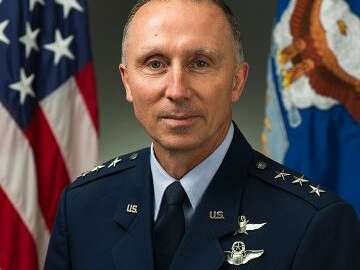The Air Force is looking to the outside world to create a procurement process purely for IT.
The service is in “the final throes” of hiring someone from the business world to examine the IT process and create a system that will quicken acquisitions, especially for cybersecurity, said Air Force Chief Information Officer Lt. Gen. Bill Bender during a Dec. 13 speech.
“It’s generally focused around this commercial off-the-shelf and as-a-service offerings that we don’t dismiss as being important, but we don’t necessarily have the mechanisms and the wherewithal to expose ourselves to it as a matter of course,” Bender said at an AFCEA event in Vienna, Virginia. “What we are trying to put in place with full partnership of [Air Force] acquisition is a different approach to IT procurement that actually looks at exposing ourselves and where it makes sense to handle IT differently.”
Bender told Federal News Radio the Air Force is hiring a senior executive from outside of government who has a good understanding for what the challenges are in DoD and what the possibilities are in the private sector.
The executive will be in charge of a team that will focus on speeding up the IT procurement process.
“We’re focusing on agility as an attribute, speed as an attribute, working together collaboratively and cross functionally when it makes sense. It’s not for everything. Not everything can be treated as a major acquisition development, some of it is small stuff like tools we are trying to put on the network and so we want to be very adaptive to the changing environment,” Bender said.
Bender said the Air Force will try to move the new procurement process from blueprint to procedure in six months.
From there the process will run as a pilot for about three years.
We will “either prove it out as a better way to do business and hand it to the acquisition community or learn along the way that we weren’t headed in the right direction and then we’ll kind of cease and desist,” Bender said.
The military has long struggled with buying IT due to the rapid nature of technology. While the defense acquisition process is slow and methodical, the pace in IT is constantly changing. The Defense Department and the military services are still searching for an answer that will deliver state-of-the-art technology to warfighters while staying within the bounds of acquisition law.
That is especially the case when it comes to large enterprise items.
“If you can stay small in terms of fielding capability we have plenty of authorities, it’s when we begin to reach into the [acquisition category] one and two is when things slow down. Once we move into the 5000 series in terms of development and procurement… All the CIOs within the department have been grappling with how to accelerate that decision cycle and then the ability to move to best of breed solutions,” said Deputy Principal Adviser to the Defense Secretary and Senior Military Adviser for Cyber Maj. Gen. Ed Wilson.
Bender hopes the person in charge of the new procurement process will learn and work with some of those smaller and faster organizations.
He said the team will be the connective tissue between the Air Force and the Defense Innovation Unit Experimental (DIUx), DoD’s outreach office to small, nontraditional tech companies. DIUx has had some success using contracting vehicles like Commercial Solutions Opening.
The process leans heavily on a significant expansion of “other transaction authorities” Congress granted to all DoD components in last year’s Defense authorization bill, including waiving requirements to comply with government cost accounting standards, giving more flexibility to negotiate intellectual property rights on a project-by-project basis, and adding the ability for DoD to use the speedier OTAs for production of fielded systems — not just prototypes — as long as it’s dealing with small or “non-traditional” companies.
Many inside and outside of DoD say that process is underutilized by the department and the services.
But Bender said contracting vehicles will only be part of the puzzle the team is trying to solve.
“The point would be end to end every part of the process. The example I would use is if you’re using an OTA and get a contract … and you have an actual RFP and contract within 30, 60 ,90 days. That’s great, but it’s only a piece of the problem. You still spent some months or even many years developing the requirement or you may not have an ability to onboard the requirement. You also may not even be aware of a new technology that actually addresses your problem,” Bender said.
Copyright
© 2024 Federal News Network. All rights reserved. This website is not intended for users located within the European Economic Area.
